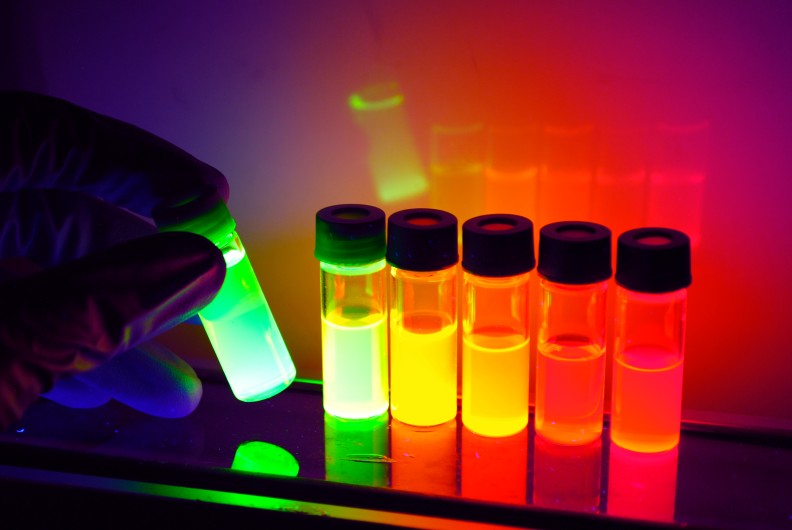The fascinating properties of quantum dots
 Quantum dots in solution absorb and emit light depending on their size.
Quantum dots in solution absorb and emit light depending on their size.
In 2023, the Nobel Prize in Chemistry was awarded to researchers Alexei Ekimov, Luis Brus and Moungi Bawendi for their contributions to the discovery and synthesis of colloidal quantum dots, nanometric spheres of semiconductors with fascinating properties. Forty years after this discovery, scientists continue to explore the physics and chemistry of these materials, while finding new applications for them. Clément Livache is one of this new generation of researchers manipulating these “quantum dots”. A chemist trained at the Ecole Nationale de Chimie de Paris, he completed his thesis at the Institut des nanosciences de Paris under the supervision of Emmanuel Lhuiller, followed by a post-doctorate in Victor Klimov's laboratory in Los Alamos (USA). He is now working on a new research project at the Laboratory of Condensed Matter for Physics (PMC*).
Virtually perfect nanocrystals
“One of the great advantages of colloidal quantum dots is that they can be synthesized using inorganic solution chemistry techniques, unlike traditional semiconductors such as silicon, which require heavy, expensive instrumentation to be produced with high purity,” explains Clément Livache. Here, precursor materials are simply used as ions in an organic solvent and heated to a few hundred degrees (60-300°C). One of the precursors is promptly injected: this is the hot injection method, invented in 1993 by Bawendi's group at MIT. “In just a few moments, billions of billions of identical, perfectly spherical and flawless nanocrystals are assembled. Rapid injection leads to a single nucleation step, enabling all the synthesized nanocrystals to reach the same size at the end of the reaction”.
One of the key properties of these nanocrystals is their size, which can be controlled by the temperature and duration of the chemical reaction. In traditional semiconductors, light properties, notably the wavelengths of light that is absorbed or emitted, depend on the composition of the material. But quantum dots are so small (on the order of 2 to 20 nanometers) that electrons experience a quantum confinement effect. The size of the quantum dot then modulates the properties set by the composition: a “big” quantum dot will emit a “redder” light than a small one. This makes it possible to continuously adapt light properties over a wide range of wavelengths, from the visible to the far infrared.
Intrinsically interdisciplinary
But Clément Livache's research is not limited to chemistry. It is inherently interdisciplinary, even more so when, as in this case, it involves setting up a new laboratory. It's a situation that the young researcher also encountered during his thesis, and which he greatly appreciated: “You have to learn a lot of things that you don't learn at school or university. You have to acquire knowledge of mechanics and electronics, think in depth about the properties you want to measure and then design the appropriate experiments with the means at your disposal. It's a real thrill!”
He is currently designing an ultra-fast spectroscopy experiment that will use lasers emitting pulses of a few millionths of a billionth of a second to directly probe the absorption properties of these materials: how long do they remain in an excited state? How do they de-excite? And how can parameters be modified during synthesis to optimize these properties?
In addition to gaining a fundamental understanding of these materials, the aim is to demonstrate their usefulness for applications. Quantum dots are already present in commercial devices. In some TV screens, they are used to emit red and green wavelengths from blue light to generate the full color palette. Cameras using quantum dots for infrared sensitivity are also beginning to be industrialized, thanks in particular to the work of Philippe Guyot-Sionnest at the university of Chicago, a former student at Ecole polytechnique, and that of Emmanuel Lhuillier's group at Sorbonne University. They can also be used as LEDs, emitting light from an electric current. Clément Livache is particularly interested in the possibility of using quantum dots to design a laser that can be tuned in the infrared and integrated on a chip, an effect that has yet to be demonstrated. “At PMC laboratory, I'm particularly well received in an environment that brings together chemists specializing in the synthesis of nanomaterials and physicists with expertise in light-matter interactions,” he says.
*PMC: a joint research unit CNRS, École Polytechnique, Institut Polytechnique de Paris, 91120 Palaiseau, France
More information:
Chemistry Nobel Prize Celebrates Colloidal Quantum Dots:
https://www.photoniques.com/articles/photon/pdf/2023/05/photon2023122p18.pdf
Scientific publication:
https://pubs.acs.org/doi/full/10.1021/acs.chemrev.2c00865
 Support l'X
Support l'X